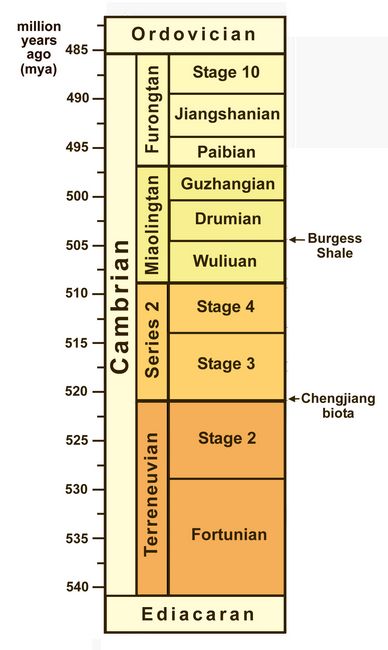Athena Review Image Archive ™
Cambrian period stages

Timeline of stages in the Cambrian period.
The
Cambrian is the first period in the Paleozoic era, lasting from 543-486
mya. The Cambrian is preceded by the Edicarian stage at the end of the
Pre-Cambrian period, and followed by the Ordovician period. It was
named in 1835 by the geologist Adam Sedgwick, after the region of
Cambria in Southern Wales and England (from the Roman name Cumbria, for
the Welsh word Cymry or "countryman").
Climate in the Cambrian period was generally a warm interval between two great ice ages in the Late Proterozoic and the Ordovician period. The megacontinent Rodinia of the Ediacaran stage, located in the southern hemisphere, began to fragment into smaller continents at the start of the Cambrian period.
The
Cambrian saw a multiplication of marine life forms, many first
identified in the Burgess Shale deposits in British Columbia. These
include a vast diversity of crustaceans, arthropods, echinoderms,
brachiopods, and early notochords, with such a vast array of evidence
leading to the concept of the "Cambrian explosion" of multicellular
life.
With recent findings of the slightly earlier Chengjiang and other biotas from China, considerable revision of the Cambrian epochs and stages has been underway. The Early Cambrian, formerly identified as the Cambrian A epoch (543-520 mya), is now called the Terrenuevian epoch. The Middle Cambrian which included the Cambrian B and C epochs (called in North America the Montezuman, Dyerian, Delmaran and Marjuman Stages), has now been revised to Series 2 and Miaolingtan epochs. The Late Cambrian, dating from 500-486 mya, formerly identified as the Cambrian D epoch (including the Steptoean and Sunwaptan Stages in North America) is now called the Furongtan epoch.
References:
.uCopyright © 1996-2020 Rust Family Foundation (All Rights Reserved).